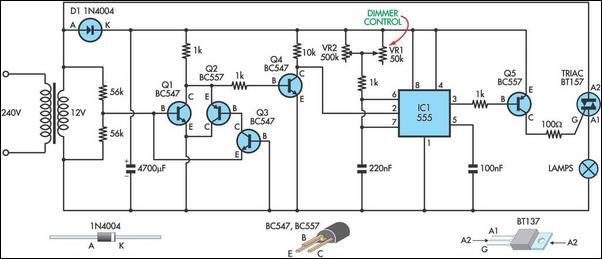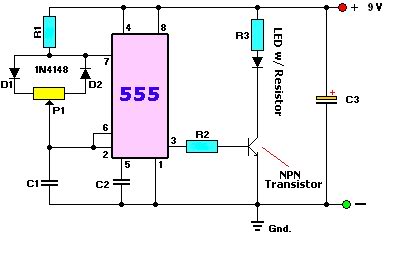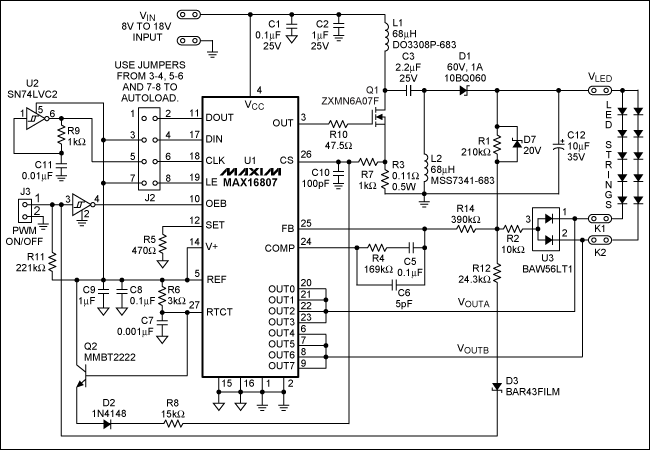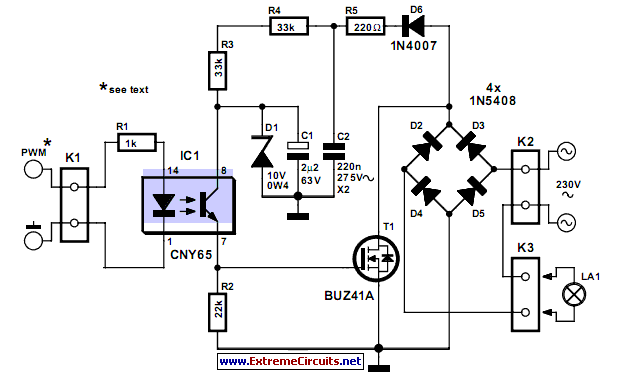
Model Theatre Lighting Dimmer

This circuit serves as the foundation for the dimmers in a model theatre lighting system that utilizes touch globes as the light source. It is centered around a 555 timer, which drives a Triac. All dimmers operate from a single power supply and share a zero-crossing detector. The circuit requires a common AC/DC return path and includes a straightforward DC supply circuit consisting of a 1N4004 diode and a 4700 µF capacitor. Transistors Q1 to Q3 form a zero-crossing detector, and the output is inverted into a negative-going pulse by Q4. This pulse is sent to the trigger input (pin 2) of the 555 IC, initiating its timing period at the start of each mains half cycle. The duration of this timing period is determined by capacitor C2 and the resistor combination of R6 with variable resistors VR1 and VR2. The output from IC1 at pin 3 is then connected to transistor Q5, which inverts this signal to trigger the Triac through a 100Ω resistor. When the timing period is brief, the Triac is activated early in the half cycle, resulting in bright lights. Conversely, a longer timing period causes the lights to dim or turn off. The primary dimmer control is potentiometer VR1, while trimpot VR2 is used to set the range of VR1. When VR1 is set to its maximum resistance, trimpot VR2 is adjusted until the lights are completely off, allowing for a full fading range with the control potentiometer.
The circuit design incorporates a 555 timer, which is a versatile integrated circuit commonly used in timing applications. In this setup, it operates in monostable mode, triggered by the zero-crossing detector. The zero-crossing detector, implemented with transistors Q1 to Q3, ensures that the timing begins precisely at the moment when the AC waveform crosses zero volts, allowing for synchronized control of the lighting.
The timing period of the 555 timer is crucial for dimming control. The capacitor C2 charges and discharges based on the resistance values of R6, VR1, and VR2. As VR1 is adjusted, the resistance changes, altering the timing interval. This adjustment directly influences how long the Triac remains on during each half cycle of the AC waveform, thus controlling the brightness of the connected lights.
Transistor Q5 plays a vital role in driving the Triac. By inverting the output signal from the 555 timer, it ensures that the Triac is triggered appropriately. The 100Ω resistor limits the current flowing into the gate of the Triac, protecting the components and ensuring reliable operation.
The overall functionality of the dimmer circuit allows for smooth transitions in lighting levels, which is particularly important in theatrical settings, where lighting can significantly impact the audience's experience. The combination of the adjustable potentiometer VR1 and the trimpot VR2 provides a flexible range of control, enabling the user to achieve desired lighting effects with precision. This circuit exemplifies a practical application of fundamental electronic components in creating an effective dimming solution for theatre lighting systems.This circuit is the basis for the dimmers in a model theatre lighting system which uses touch globes as the light source. The circuit is based around a 555 timer, driving a Triac. All dimmers share the one power supply and zero-crossing detector. As it will only work if there is a common AC/DC return path, it has a simple DC supply circuit consist
ing of one 1N4004 diode and one 4700 µF capacitor. Transistors Q1 to Q3 comprise a zero-crossing detector whose output is inverted into a negative-going pulse by Q4. This pulse is fed to the trigger input (pin 2) of the 555 IC which then starts its timing period at the beginning of each mains half cycle.
The length of this period is set by capacitor C2 and the combination of resistors R6 with pots VR1 and VR2. The output of IC1 at pin 3 is then fed to transistor Q5 which inverts this signal to trigger the Triac via a 100# resistor.
When the timing period is short, the Triac is turned on early in half cycle and lights are bright. Conversely, when the timing period is longer, the lights are dim or turned off. The main dimmer control is potentiometer VR1. Trimpot VR1 is used to set the range of VR1. With VR1 set fully clockwise (ie, maximum resistance) trimpot VR2 is adjusted until the lights are just turned off. The lights should then be able to be faded over the full range by the control potentiometer. 🔗 External reference
The circuit design incorporates a 555 timer, which is a versatile integrated circuit commonly used in timing applications. In this setup, it operates in monostable mode, triggered by the zero-crossing detector. The zero-crossing detector, implemented with transistors Q1 to Q3, ensures that the timing begins precisely at the moment when the AC waveform crosses zero volts, allowing for synchronized control of the lighting.
The timing period of the 555 timer is crucial for dimming control. The capacitor C2 charges and discharges based on the resistance values of R6, VR1, and VR2. As VR1 is adjusted, the resistance changes, altering the timing interval. This adjustment directly influences how long the Triac remains on during each half cycle of the AC waveform, thus controlling the brightness of the connected lights.
Transistor Q5 plays a vital role in driving the Triac. By inverting the output signal from the 555 timer, it ensures that the Triac is triggered appropriately. The 100Ω resistor limits the current flowing into the gate of the Triac, protecting the components and ensuring reliable operation.
The overall functionality of the dimmer circuit allows for smooth transitions in lighting levels, which is particularly important in theatrical settings, where lighting can significantly impact the audience's experience. The combination of the adjustable potentiometer VR1 and the trimpot VR2 provides a flexible range of control, enabling the user to achieve desired lighting effects with precision. This circuit exemplifies a practical application of fundamental electronic components in creating an effective dimming solution for theatre lighting systems.This circuit is the basis for the dimmers in a model theatre lighting system which uses touch globes as the light source. The circuit is based around a 555 timer, driving a Triac. All dimmers share the one power supply and zero-crossing detector. As it will only work if there is a common AC/DC return path, it has a simple DC supply circuit consist
ing of one 1N4004 diode and one 4700 µF capacitor. Transistors Q1 to Q3 comprise a zero-crossing detector whose output is inverted into a negative-going pulse by Q4. This pulse is fed to the trigger input (pin 2) of the 555 IC which then starts its timing period at the beginning of each mains half cycle.
The length of this period is set by capacitor C2 and the combination of resistors R6 with pots VR1 and VR2. The output of IC1 at pin 3 is then fed to transistor Q5 which inverts this signal to trigger the Triac via a 100# resistor.
When the timing period is short, the Triac is turned on early in half cycle and lights are bright. Conversely, when the timing period is longer, the lights are dim or turned off. The main dimmer control is potentiometer VR1. Trimpot VR1 is used to set the range of VR1. With VR1 set fully clockwise (ie, maximum resistance) trimpot VR2 is adjusted until the lights are just turned off. The lights should then be able to be faded over the full range by the control potentiometer. 🔗 External reference





